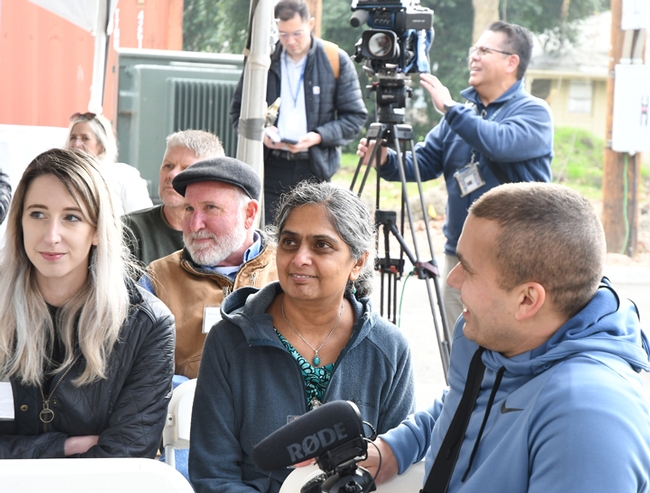
That's because bees don't fly until the temperature hits around 55, and the thermometer on that wintry day (Jan. 7) refused to budge over 47.
The facility, part of the U.S. Department of Agriculture's Agricultural Research Service, is located next to the UC Davis Department of Entomology and Nematology's Harry H. Laidlaw Jr. Honey Bee Research Facility on Bee Biology Road, west of the central campus.
It slides Davis into the national spotlight as "Pollination Central" and "The Bee Capital of the World." The Davis facility is the newest of five USDA bee research labs in the United States and as the only one in California.
“This is the only USDA bee research team in California—where the action is,” said emcee Paul Pratt, research leader of the Invasive Species and Pollinator Health Research Lab. USDA maintains honey bee research facilities in Tucson, Ariz.; Beltsville, M.D., Baton Rouge, La., and Stoneville, Miss.
“The opening of the USDA-ARS bee lab marks a new opportunity for USDA and UC Davis entomologists to collaborate and investigate serious problems that affect stakeholders,” said Steve Nadler, professor and chair of the UC Davis Department of Entomology and Nematology. “We are very fortunate that the lab was built at UC Davis.”
Plans for the USDA-ARS facility began five years ago at a stakeholders' conference in the Laidlaw facility. Attendees at the November 2015 meeting targeted honey bee health, primarily varroa mites, pesticides and nutrition.
Park-Burris, of Jackie Park-Burris Queens, Palo Cedro--her family has worked with UC Davis researchers for more than 80 years--cut the ribbon with four other stakeholders: almond pollination consultant Robert Curtis of Carmichael, former director and associate director (now retired) of Agricultural Affairs, Almond Board of California; Kevin Adee of Bruce, S.D., president of the American Honey Producers' Association; Brad Pankratz of Can-Am Apiaries, Orland, Calif.; and Darren Cox of Cox Honey Farms, Logan, Utah, a past president of the American Honey Producers' Association.
Pratt introduced newly hired research entomologists, Arathi Seshadri and Julia Fine, who form the Invasive Species and Pollinator Health Research Unit at Davis. They are dedicated toward developing technology that improves colony survivorship through long-term studies of multiple stress factors, he said. "They will develop and transfer integrated biologically based approaches for the management of invasive species and the improvement of pollinator health.”
The speakers centered their presentations around cooperation, camaraderie, and, yes, the cold! (See new story and images on the UC Davis Department of Entomology and Nematology website.)
Park-Burris said it well:
"The California State Beekeepers' Association is overwhelmed that we have a USDA lab to collaborate with our UC Davis lab. We hope there's a lot of collaboration going on. We really look forward to that. As a stakeholder, my family has been raising queens just north of here (Palo Cedro) for over 80 years. Dr. Laidlaw had worked with my uncle and my father. He's been at my house. And he's been through my bees. Julia (Fine) has even already been up to see the queen farm.” (See more information on Harry Hyde Laidlaw Jr., 1907-2003, the father of honey bee genetics, on the UC Davis website.)
“The queen bee breeding industry could definitely use you guys,” Park-Burris continued. “California has all the issues because everybody comes here. …it's very important that we have this lab here and how grateful we are that you have all gone to the work to make this happen."
“We look forward to solving some of our problems—varroa, varroa, varroa--and forage and pesticide interaction,” Park-Burris said, “and all that happens in California during the largest pollinator event in the world. So you're in a good place and we're grateful.”
The bees? They're grateful, too.
Attached Images:
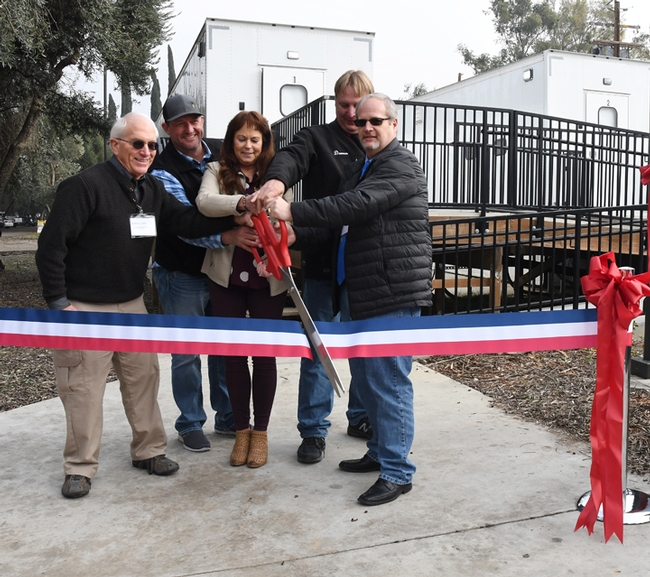
Ready to cut the ribbon (from left) are almond pollination consultant Robert Curtis of Carmichael, retired director of agricultural affairs, Almond Board of California; Brad Pankratz of Can-Am Apiaries, Orland; Jackie Parks-Burris of Jackie Park-Burris Queen Bees, Palo Cedro and a past president of California State Beekeepers' Association; Darren Cox, Logan, Utah, past president of American Honey Producers; and Kelvin Adee of Bruce, S.D., president of American Honey Producers.
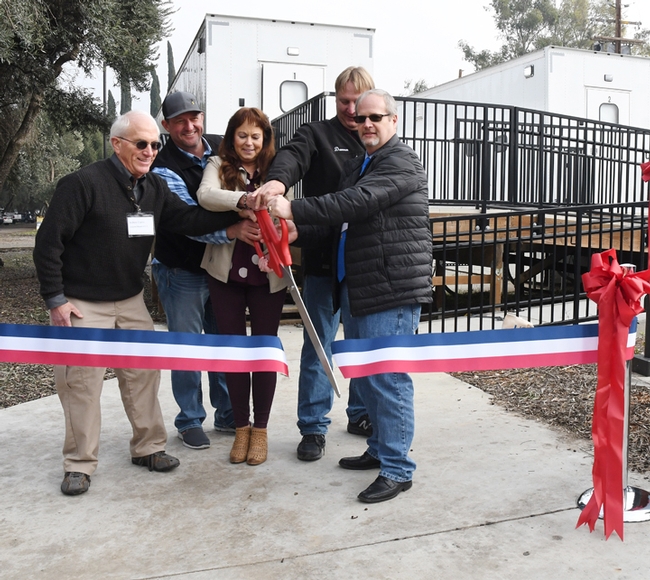
And it's snipped! From left are almond pollination consultant Robert Curtis of Carmichael, retired director of agricultural affairs, Almond Board of California; Brad Pankratz of Can-Am Apiaries, Orland; Jackie Parks-Burris of Jackie Park-Burris Queen Bees, Palo Cedro and a past president of California State Beekeepers' Association; Darren Cox, Logan, Utah, past president of American Honey Producers; and Kelvin Adee of Bruce, S.D., president of American Honey Producers.
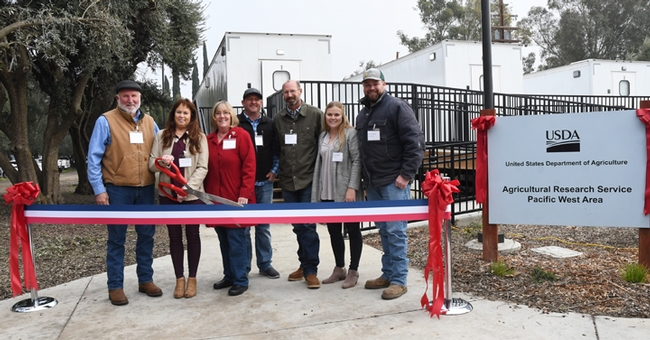
California State Beekeepers' Association members pose for a photo. From left are Steve Godlin, Jackie Park-Burris, Valeri Severson, Brad Pankratz, Buzz Landon, Brooke Palmer, and Trevor Tauzer.
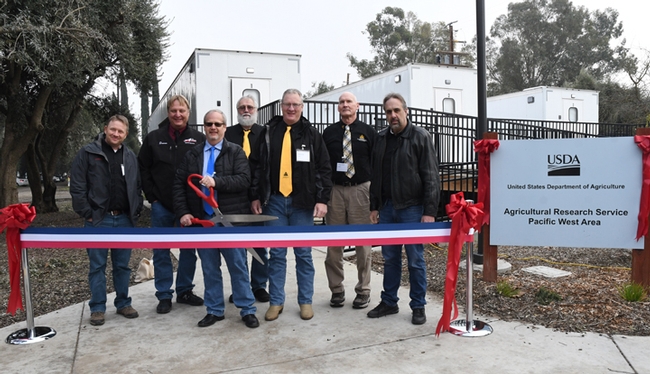
The American Honey Producers Association with the ribbon. Wielding the scissors is Kelvin Adee of Bruce, S.D., president of American Honey Producers. The group later held a conference in Sacramento.
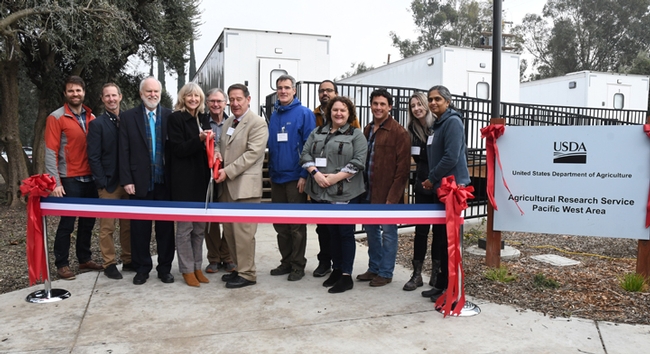
UC Davis-affiliated personnel pose with USDA personnel for a ribbon-cutting photo. From left are Charley Nye, UC Davis; Paul Pratt of USDA; Kevin Hackett of USDA; Anita Oberbauer of UC Davis; Eric Mussen of UC Davis; Robert Matteri of USDA; Neal Williams, Brian Johnson, Elina Niño and Bernardo Niño, all of UC Davis; and Julia Fine and Arathi Seshadri, USDA.
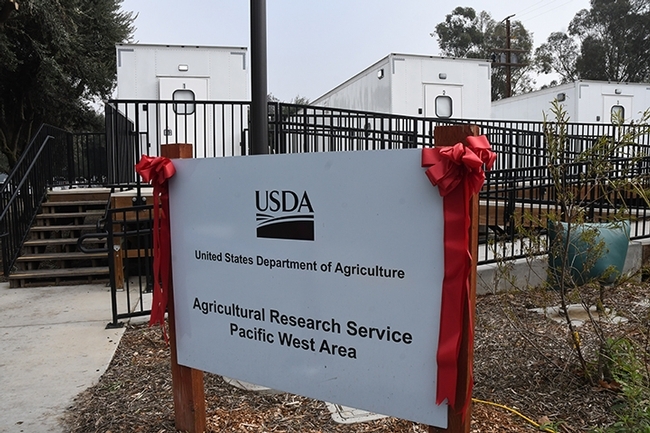
Much collaboration, cooperation, and camaraderie is expected here at the newly opened USDA-ARS bee research facility on Bee Biology Road, UC Davis.